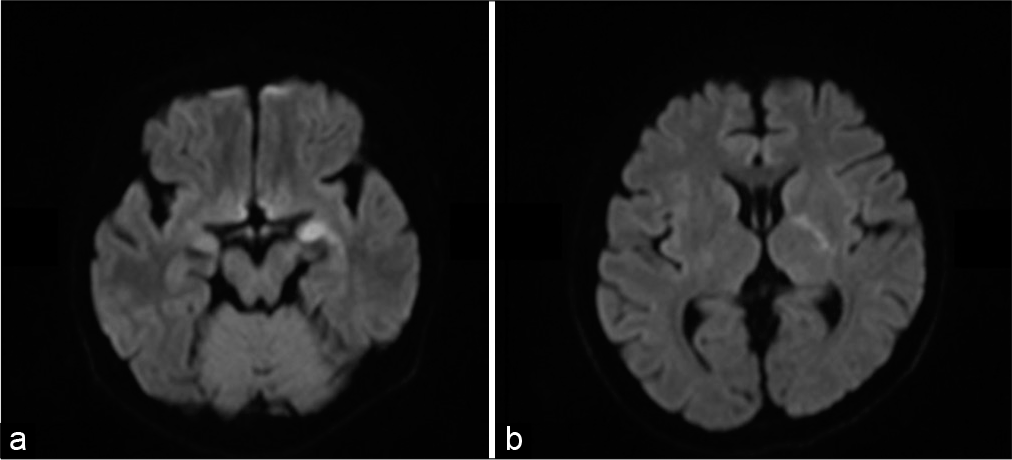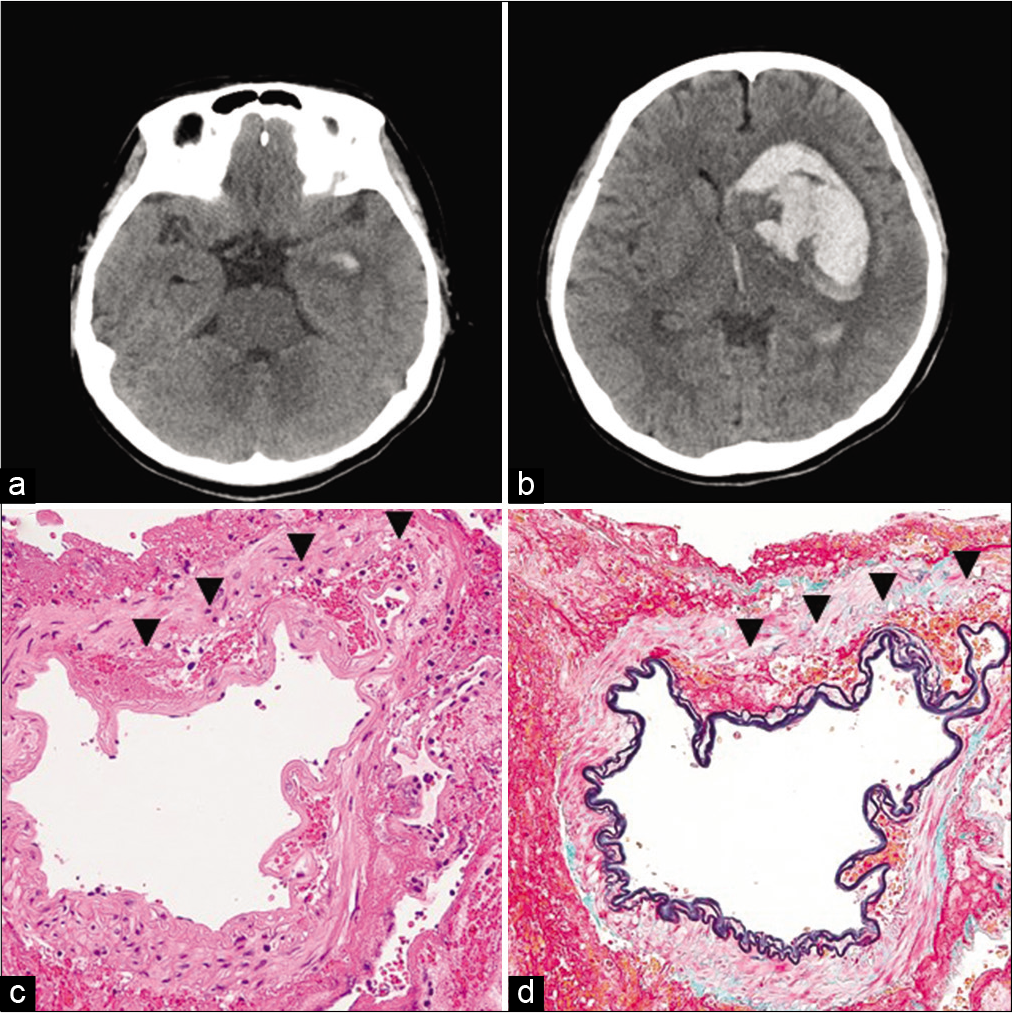- Departments of Neurosurgery, National Hospital Organization Sendai Medical Center, Sendai, Miyagi, Japan,
- Pathology, National Hospital Organization Sendai Medical Center, Sendai, Miyagi, Japan,
- Department of Neurosurgery, Tohoku University Graduate School of Medicine, Sendai, Miyagi, Japan.
Correspondence Address:
Hiroyuki Sakata, Department of Neurosurgery, National Hospital Organization Sendai Medical Center, Sendai, Miyagi, Japan.
DOI:10.25259/SNI_938_2021
Copyright: © 2022 Surgical Neurology International This is an open-access article distributed under the terms of the Creative Commons Attribution-Non Commercial-Share Alike 4.0 License, which allows others to remix, transform, and build upon the work non-commercially, as long as the author is credited and the new creations are licensed under the identical terms.How to cite this article: Tomohisa Ishida1, Hiroyuki Sakata1, Masayuki Ezura1, Takashi Inoue1, Atsushi Saito1, Hiroyoshi Suzuki2, Teiji Tominaga3. Potential hemorrhagic risk of endovascular revascularization therapy due to recanalization of the dissected perforator in intracranial internal carotid artery dissection: A case report. 25-Feb-2022;13:71
How to cite this URL: Tomohisa Ishida1, Hiroyuki Sakata1, Masayuki Ezura1, Takashi Inoue1, Atsushi Saito1, Hiroyoshi Suzuki2, Teiji Tominaga3. Potential hemorrhagic risk of endovascular revascularization therapy due to recanalization of the dissected perforator in intracranial internal carotid artery dissection: A case report. 25-Feb-2022;13:71. Available from: https://surgicalneurologyint.com/surgicalint-articles/11410/
Abstract
Background: Intracranial internal carotid artery (ICA) dissection manifesting as ischemic stroke is rare. Although endovascular revascularization therapy is effective in preventing the progression of stroke, little is known about the potential risk of this therapeutic approach.
Case Description: We report a case of a 38-year-old woman who presented with acute ischemic infarcts in the territory of the left anterior choroidal artery (AChA) due to intracranial ICA dissection. She underwent balloon angioplasty, resulting in the complete resolution of the stenosis. The AChA, which was nearly occluded preoperatively, was unexpectedly recanalized after the procedure. Four hours later, she developed a parenchymal hemorrhage in the left basal ganglia without subarachnoid hemorrhage. The AChA, suspected as the hemorrhagic source during surgical hematoma removal, was revealed to have a disrupted internal elastic lamina on pathological examination, suggesting that the dissection of the ICA extended to the AChA.
Conclusion: To the best of our knowledge, this is the first case report demonstrating that the intracranial ICA dissection extends to the associated perforator. Considering the potential risk of subsequent hemorrhagic complications by recanalization of the dissected perforator, prudent postoperative management, including strict blood pressure control, is advisable following endovascular revascularization therapy against intracranial artery dissection involving perforators.
Keywords: Dissected perforator, Endovascular therapy, Hemorrhagic complication, Intracranial internal carotid artery dissection
INTRODUCTION
Intracranial artery dissection is a rare entity, occurring in 3.6–4.4 per 100,000 people per year.[
Endovascular revascularization therapy has been reported to effectively counteract intracranial ICA dissection manifesting as ischemic stroke.[
Here, we report a case of intracranial ICA dissection with ischemic onset, with a complication of remote parenchymal hemorrhage due to a recanalized dissected perforator following endovascular therapy. We also sought to elucidate the mechanism underlying postoperative hemorrhagic complications and suggest a treatment strategy from both angiographic and pathological points of view.
CASE DESCRIPTION
A 38-year-old woman with no medical history presented with progressive hemiparesis on the right side and total aphasia following a sudden headache. Magnetic resonance imaging revealed acute ischemic infarcts in the territory of the left anterior choroidal artery (AChA) [
Figure 2:
(a) Preoperative angiography revealing irregular stenosis of the left supraclinoid internal carotid artery (ICA). (b) Cone-beam computed tomography demonstrating the intimal flap at the lesion site. (c) Preoperative working angle. Note that the anterior choroidal artery (AChA) is nearly occluded (arrow). (d) Balloon angioplasty performed. (e) Postoperative working angle showing the resolution of the ICA stenosis and the complete recanalization of AChA (arrow).
We planned to perform percutaneous transluminal angioplasty (PTA) using a balloon dilatation catheter, with or without stent placement, depending on the PTA results. The patient received oral antiplatelet drugs with loading doses (aspirin 200 mg and clopidogrel 300 mg), together with intravenous heparin during the procedure to maintain the activated coagulation time in the range of 250–300 s. An 8-Fr occlusion balloon-guiding catheter (Cello; Medtronic, Minneapolis, MN, USA) was navigated to the left cervical ICA using a transfemoral approach. After a Gateway Monorail 2.5 × 12 mm (Stryker, Kalamazoo, MI, USA) was introduced into the lesion, the balloon was inflated by increasing the pressure to 6 atm for approximately 60 s [
The patient’s ischemic symptoms improved dramatically soon after the procedure; however, her consciousness level suddenly declined 4 h later. An emergency computed tomography revealed a parenchymal hemorrhage in the left basal ganglia without any evidence of subarachnoid hemorrhage [
Figure 3:
(a and b) Computed tomography obtained after patient deterioration, showing the intraparenchymal hemorrhage in the left basal ganglia without any evidence of subarachnoid hemorrhage. (c and d) Pathological examination of the resected anterior choroidal artery by hematoxylin and eosin staining (c) and elastic Masson staining (d). Note that the internal elastic lamina is disrupted and the red blood cells are present in the subintimal planes (arrowhead).
DISCUSSION
Although the natural history of ischemic stroke due to intracranial ICA dissection has not been studied in greater detail than that of other types of steno-occlusive lesions, ICA dissection is reportedly associated with a high rate of recurrent ischemic events.[
The most interesting finding in the present case is that the resected AChA, which is probably responsible for the hemorrhagic complication, showed evidence of dissection, which was confirmed by pathological examination. Dissection in a perforator has been reported previously as the cause of parenchymal hemorrhage.[
Another possible underlying mechanism is reperfusion injury. Endovascular recanalization therapy for stenoocclusive lesions has a potential risk of hemorrhagic complications (3.1%).[
CONCLUSION
This is the first case report demonstrating that the intracranial ICA dissection extends to the associated perforator. In cases of intracranial ICA dissection involving the perforator, occasional recanalization of the perforator may increase the risk of subsequent hemorrhagic complications following endovascular recanalization therapy. Prudent postoperative management, including blood pressure control, should be advised considering the potential hemorrhagic risk due to recanalized perforators.
Declaration of patient consent
The authors certify that they have obtained all appropriate patient consent.
Financial support and sponsorship
We are supported from JSPS KAKENHI (Grant Number P19K18414). No other financial support is received.
Conflicts of interest
There are no conflicts of interest.
References
1. Ahn JY, Chung SS, Lee BH, Kim SH, Yoon PH, Joo JY. Treatment of spontaneous arterial dissections with stent placement for preservation of the parent artery. Acta Neurochirurg. 2005. 147: 265-73
2. Bond KM, Krings T, Lanzino G, Brinjikji W. Intracranial dissections: A pictorial review of pathophysiology, imaging features, and natural history. J Neuroradiol. 2021. 48: 176-88
3. Chaves C, Estol C, Esnaola MM, Gorson K, O’Donoghue M, De Witt LD. Spontaneous intracranial internal carotid artery dissection: report of 10 patients. Arch Neurol. 2002. 59: 977-81
4. Debette S, Compter A, Labeyrie MA, Uyttenboogaart M, Metso TM, Majersik JJ. Epidemiology, pathophysiology, diagnosis, and management of intracranial artery dissection. Lancet Neurol. 2015. 14: 640-54
5. Hayakawa M. Reperfusion-related intracerebral hemorrhage. Front Neurol Neurosci. 2015. 37: 62-77
6. Izumi T, Nishibori M, Imamura H, Iihara K, Sakai N, investigators JN. Endovascular therapy for intracranial artery stenosis: Results from the Japanese registry of neuroendovascular therapy (JR-NET)3. Neurol Med Chirurg. 2020. 60: 256-63
7. Khatri R, McKinney AM, Swenson B, Janardhan V. Blood-brain barrier, reperfusion injury, and hemorrhagic transformation in acute ischemic stroke. Neurology. 2012. 79: S52-7
8. Kim DJ, Kim BM, Suh SH, Kim DI. Self-expanding stent placement for anterior circulation intracranial artery dissection presenting with ischemic symptoms. Neurosurgery. 2015. 76: 158-64
9. Kondo R, Matsumoto Y, Suzuki I, Kikuschi T, Shimizu H, Fujiwara S. Stent placement for intracranial internal carotid artery dissection presenting with ischemic stroke. JNET. 2012. 6: 164-74
10. Lylyk P, Cohen JE, Ceratto R, Ferrario A, Miranda C. Angioplasty and stent placement in intracranial atherosclerotic stenoses and dissections. AJNR Am J Neuroradiol. 2002. 23: 430-6
11. Mizutani T, Kojima H, Miki Y. Arterial dissections of penetrating cerebral arteries causing hypertension-induced cerebral hemorrhage. J Neurosurg. 2000. 93: 859-62
12. Oka F, Shimizu H, Matsumoto Y, Watanabe M, Tominaga T. Ischemic stroke due to dissection of intracranial internal carotid artery: Implications for early surgical treatment. Surg Neurol. 2008. 69: 578-84
13. Rao AS, Makaroun MS, Marone LK, Cho JS, Rhee R, Chaer RA. Long-term outcomes of internal carotid artery dissection. J Vasc Surg. 2011. 54: 370-4
14. Shahi V, Fugate JE, Kallmes DF, Rabinstein AA. Early basal ganglia hyperperfusion on CT perfusion in acute ischemic stroke: A marker of irreversible damage?. AJNR Am J Neuroradiol. 2014. 35: 1688-92
15. Shindo A, Matsumoto A, Shishido H, Okauchi M, Hayashi N, Kawakita K. Two cases of intracranial internal carotid artery dissection presenting with ischemic stroke. J Neuroendovasc Ther. 2017. 11: 253-9
16. Yap L, Patankar T, Pysden K, Tyagi A, Goddard T. Spontaneous dissecting lenticulostriate artery aneurysm in children: Radiologic findings and clinical management. J Child Neurol. 2015. 30: 1060-4








